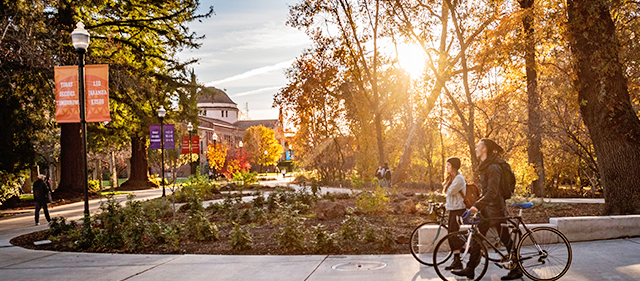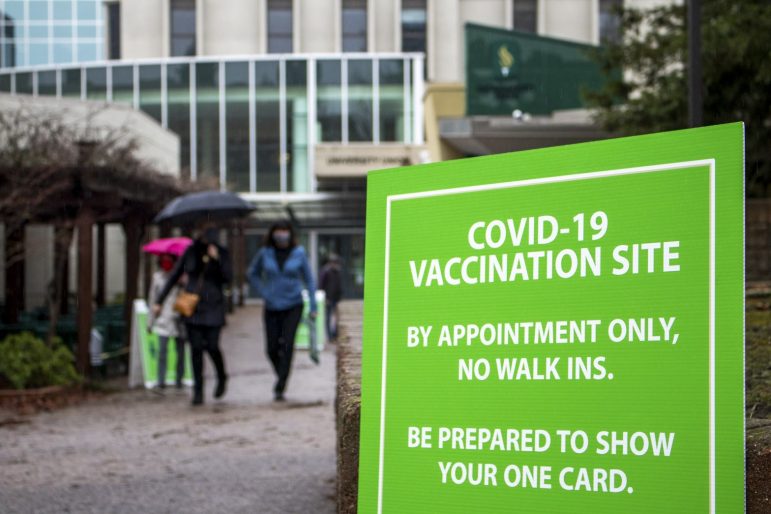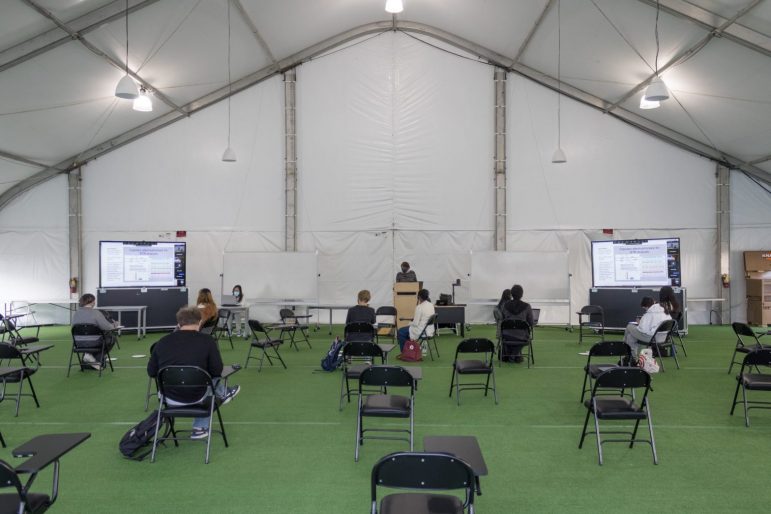In mid-January, science education professor Al Schademan received one of around 2,000 emails sent to faculty, student employees and essential staff at California State University, Chico. The email contained a surprise for Schademan: He would be among the first higher education employees in California to gain coveted access to the coronavirus vaccine.
Within a couple weeks, Schademan was climbing a back stairway at the 298-bed Enloe Medical Center, where in a room above the hospital cafe he received his first shot of the Pfizer vaccine, an adventure he said felt like participating in a covert operation.
Getting vaccinated was a relief, said Schademan, who’s now considering teaching in-person in the fall.

“I’m just hopeful we can get back to normal, because staring at a computer all day is not fun,” he said.
Chico State is one of at least three California State University campuses offering the coronavirus vaccine to faculty, staff or student employees. Other California colleges may soon follow as the state’s vaccine rollout continues and supply increases. But most colleges and universities say they’re not likely to require members of the campus community to be vaccinated — even as they plan to ramp up in-person learning.
Educators qualify for vaccine prioritization in the current 1B phase of California’s vaccine rollout. Vaccine availability varies by county, however, meaning some colleges have been able to begin immunizations while others still await guidance from local health officials. Vaccination is key to colleges’ reopening plans given previous coronavirus outbreaks fueled by students gathering in dorms and off-campus housing.
Chico State was able to vaccinate faculty and staff because the local Butte County Public Health Department has moved swiftly through the vaccination process. The county is on track to finish vaccinating K-12 employees in March, and has also offered doses to instructors at Butte College and technical schools, said communications manager Lisa Almaguer.
Besides faculty, Chico State decided to offer doses of the vaccine to frontline student employees such as lifeguards and resident advisors, said Mike Guzzi, director of the university’s emergency operations center. “They’re mingling with large populations, and we wanted to give them the opportunity to be vaccinated,” he said.
California State University, Long Beach began offering vaccine appointments February 2 at their Walter Pyramid parking lot vaccine center. More than 2,000 campus community members had received both shots of the vaccine as of February 22, according to the university’s vaccine dashboard. The city of Long Beach has its own public health department, a fact that has allowed it to distribute vaccines quickly and efficiently, said Mayor Robert Garcia.
CSU and University of California campuses are also helping distribute vaccines to the wider community. Eleven of the 23 CSU campuses have on-site vaccination centers, and more are expected to come online within the next few weeks, according to CSU spokesperson Mike Uhlenkamp. UC San Diego partnered with San Diego County on one of the state’s largest mass vaccination sites, adjacent to Petco Park in San Diego.

Colleges pass on vaccine mandate
While CSU and UC have said they will encourage students and staff to be vaccinated, they have no current plans to require it.
“Our focus is really to try to get the vaccines here to each campus and to inspire participation,” CSU Chancellor Joseph Castro said at a Feb. 8 press conference with student media. “There may be some students for different reasons who decide they don’t wish to be vaccinated, or a staff or faculty member who doesn’t wish to do so. I’m going to respect that and really focus on trying to get as many people vaccinated as possible.”
Castro added that he wanted to avoid any legal issues that could accompany mandating a vaccine that has been approved by the Food and Drug Administration for emergency use only.
The emergency use authorization — a rarity in U.S. history — is the main issue driving legal uncertainty around whether campuses can require the vaccine, said UC Hastings College of the Law professor Dorit Reiss. Some colleges already require other immunizations for students who want to attend; UC, for example, made flu shots mandatory for students, faculty and staff last year.
If colleges do eventually decide to start mandating a COVID-19 vaccine, Reiss and other legal experts said, the requirement could survive legal challenges by being narrowly tailored to protect public health and allowing individuals to opt out for medical or religious reasons.
“The Civil Rights Act of 1964 does say you can’t discriminate in education based on religion, but that only requires accommodation if the accommodation is no more than a minimal burden,” Reiss said. “A university can say allowing students to bring in COVID-19, measles, influenza is more than a minimal burden. It can also say, ‘We’re offering an accommodation. The accommodation is if you don’t want to get the vaccine, take the course online.’”
At California State University, Sacramento, administrators considered requiring students to be vaccinated but changed course after hearing from the chancellor’s office, said Cely Smart, chief of staff to campus president Robert Nelsen.
“We initially thought that we would be able to (mandate the vaccine), especially for our student population, in the way that we do meningitis and some of the other immunizations,” Smart said. CSU officials advised against that due to concerns about the emergency use authorization, Smart said. But if the vaccine is approved for non-emergency use, Smart said, she believes the university would revisit that requirement “pretty quickly.”
Sacramento State has been offering on-campus vaccines to employees on a voluntary basis since Feb. 16, Smart said.
In-person learning expands
As the vaccine rollout continues, a few California colleges are increasing the number of students attending class in-person in outdoor tents and even indoor classrooms. Their efforts provide a glimpse of what campus operations could look like statewide this fall.
At UC San Diego, about 2,200 students are taking classes in 50-person tents equipped with wifi, weatherproof speakers, podcasting equipment, whiteboards and display screens. The university began experimenting with in-person pandemic learning last fall, when 10% of its courses were offered face-to-face. Both students and faculty are required to wear face coverings, and seats are spaced at least six feet apart, said spokesperson Leslie Sepuka.

Simon Poon, a freshman studying physics, heads for a tent each week to participate in an in-person discussion section, and says he likes it a lot better than Zoom. “I can see the person, so I’m more likely to ask questions,” he said. Though he sits six feet apart from classmates, they sometimes rotate their chairs toward each other for group work. “Even if I’m just working by myself, I still like to be with people,” he said.
The campus hasn’t seen any evidence of COVID-19 transmission as a result of in-person classes, Sepuka said, and plans to add limited indoor instruction later this spring, with each class restricted to either 25% capacity or 50 students, whichever is smaller.

UC Berkeley also began offering indoor classes this week, despite a coronavirus outbreak earlier in the semester that saw students confined to their dorms. Classes will be capped at 26 students, said spokesperson Janet Gilmore, with all students required to test weekly for COVID-19, complete a daily symptom screening and wear a mask. Students in the university’s Rausser College of Natural Resources are conducting outdoor labs, string ensembles are rehearsing al fresco, and engineering students are attending outdoor meetings.
Stanford University said this week that it will bring juniors and seniors back to campus for the spring quarter that starts March 29, though most classes will remain online. “We believe our campus is prepared to respond effectively to positive cases that occur,” Stanford President Marc Tessier-Levigne and Provost Persis Dell wrote in a message to students, according to the Stanford Daily. The move was opposed by Stanford’s student government, who argued bringing students back would place a heavier burden on local hospitals, citing a small uptick in Covid cases during the winter quarter and some students’ refusal to comply with safety measures.
Planning for fall
But most California colleges, including the UC and CSU systems overall, are focused on Fall 2021 as the date for a return to campus life. Dr. Anthony Fauci, the nation’s top infectious disease expert, sparked optimism among higher education leaders in December when he predicted that most college students could be vaccinated by late summer.
Bringing students back to campus is important for not just colleges’ culture and learning environments, but also their bottom lines; many have lost millions of dollars in revenue as students stopped paying for dorms and meal plans.
“We all want to get back to normal, knowing that normal is not what it was before, but we’re working really hard to bring back our students and to have that on campus interaction,” said Kristen Soares, president of the Association of Independent California Colleges and Universities, which represents private colleges.
Some students say they’re cautious about returning. Alissa Vasquez had been looking forward to transferring to Cal State Northridge from community college this fall, and reuniting with friends there. But if her campus doesn’t require students to be vaccinated, Vasquez said, she worries that she’ll endanger her immunocompromised grandmother by commuting from her family home to in-person classes.
“As much as I’d love to have that college experience and see the university firsthand, I just still don’t feel safe,” Vasquez said.
When UC student leaders met with President Michael Drake to discuss the university’s return to in-person learning, they urged him to give students flexibility, said UC Santa Cruz student body president Shivika Sivakumar.
“We are really pushing for a hybrid option because we know not everyone would be vaccinated by then,” Sivakumar said. “Most of our talk with President Drake was, ‘When you come up with a plan of action, make sure you’re keeping in mind that there are different student groups and different staff professionals who are going through different things right now. If you make remote not an option anymore, it’s going to be hard.’ ”
Faculty, too, are pushing to have a voice in universities’ fall plans.
Schademan, the Chico State science education professor, said administrators there did not consult with instructors before deciding that 20 to 30% of fall classes would be in-person. As he weighs returning to the classroom, he said a lot of questions remain unanswered — such as whether he’ll have access to the sinks and supplies he needs to effectively train new science teachers.
“If you don’t get input from the people who are going to be in the classrooms actually doing the teaching, then whatever plan you come up with is not going to work,” said Schademan, who is also the faculty rights chair for the Chico State chapter of the California Faculty Association.
Even after more students and employees are vaccinated, colleges shouldn’t expect a return to the carefree days of 2019, said Gerri Taylor, co-chair of the American College Health Association’s COVID-19 task force.
Students will still need to wear masks, be tested for the virus regularly — her organization recommends at least once upon arrival to campus and twice a week after that — quarantine if exposed and socially distance within the classroom, she said.
And new variants could prompt a need to create new vaccines that students in coming years will have to receive, she said. “It may become a yearly occurrence, just like the flu vaccine.”
